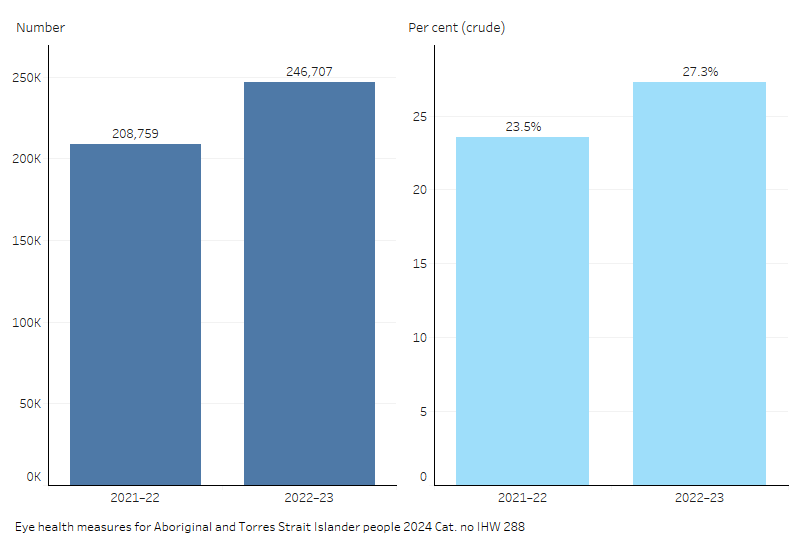The number and proportion of First Nation people who had a First Nations-specific health assessment: Measure 2.1.1
On this page:
All First Nations people, regardless of age, are eligible for a First Nations-specific health assessment which should include an eye health check.
This measure includes in-person health assessments (Medicare Benefits Schedule (MBS) item 715 or 228), and assessments provided via videoconference or teleconference (MBS item 92004, 92011, 92016, 92023). Note that MBS items 92016 and 92023 were removed from the MBS as of 1 July 2021.
Latest data
In 2022–23, just over one-quarter (246,707 or 27%) of First Nations people had a health assessment. This included over 2,500 health assessments provided via videoconference or teleconference (Figure 13).
Figure 13: Annual health assessments, 2021–22 and 2022–23

Notes
- 'MBS health assessment' includes MBS items 715 and 228.
- Includes telehealth assessments (items 92004, 92011, 92016 and 92023).
- Counts have been adjusted to avoid double counting patients across age groupings, geographical classifications and assessment types.
- Data reported by date of service.
Source: AIHW analysis of Medical Benefits Schedule data.
Explore more aspects of the data in the following section. See also Figure 14.
By remoteness
In 2022–23, the proportion of First Nations people who had a health assessment was highest in Outer regional and Remote areas (35% and 29%, respectively); it was 27% in Inner regional areas and around 25% in Major cities and 23% in Very Remote areas (Figure 14 – remoteness).
By jurisdiction
In 2022–23, the proportion of First Nations people who had a health assessment was highest in Queensland (34%) and the Northern Territory (28%), (Figure 14 – jurisdiction).
By age and sex
In 2022–23, the number and proportion of First Nations males aged 0–14 who had a health assessment was slightly higher than the number and proportion of females of the same age – 38,188 (26%) and 34,092 (24%), respectively. For all other age groups, health assessments for First Nations females outnumbered those for First Nations males (Figure 14 – population groups).
By Primary Health Network
In 2022–23, the Primary Health Networks (PHN) with the highest proportion of First Nations people who had a health assessment were Northern Queensland (38%) and Darling Downs and West Moreton (37%) (Figure 14 – geography).
Time trend
The age-specific proportion of First Nations people who had a health assessment was between 10% and 14% in 2011–12 for age groups 44 years and under, it increased to between 22% and 28% for age groups 44 years and under in 2022–23. The proportion of First Nations people in all age groups aged 45 and over who had a health assessment rose from between 17% and 23% in 2011–12 to between 33% and 43% in 2022–23 (Figure 14 – time trend).
Figure 14: Annual health assessments: interactive data
The following extended descriptions are provided to assist people using screen readers. To download the data tables, visit Data.
Sex, age, Percent First Nations had health check
Female
0–14, 24.2
15–24, 25.8
25–34, 28.8
35–44, 32.6
45–54, 35.9
55–64, 39.8
65–74, 43.4
75+, 43.5
Male
0–14, 25.7
15–24, 18.4
25–34, 17.7
35–44, 23.9
45–54, 30.6
55–64, 36.6
65–74, 40.4
75+, 41.6
Primary Health Network, PHN type, Percent First Nations had a health check
Adelaide, Metropolitan, 18.8
Australian Capital Territory, Metropolitan, 17.4
Brisbane North, Metropolitan, 32.1
Brisbane South, Metropolitan, 35.3
Central Queensland, Wide Bay, Sunshine Coast, Regional, 29.1
Central and Eastern Sydney, Metropolitan, 14.8
Country SA, Regional, 23.3
Country WA, Regional, 27.3
Darling Downs and West Moreton, Regional, 36.7
Eastern Melbourne, Metropolitan, 8.4
Gippsland, Regional, 12.4
Gold Coast, Metropolitan, 24.9
Hunter New England and Central Coast, Regional, 31.6
Murray, Regional, 19.4
Murrumbidgee, Regional, 26.9
Nepean Blue Mountains, Metropolitan, 22.6
North Coast, Regional, 24.6
North Western Melbourne, Metropolitan, 12.5
Northern Queensland, Regional, 37.9
Northern Sydney, Metropolitan, 6.7
Northern Territory, Regional, 28.3
Perth North, Metropolitan, 23.9
Perth South, Metropolitan, 23.5
South Eastern Melbourne, Metropolitan, 9.6
South Eastern NSW, Regional, 23.8
South Western Sydney, Metropolitan, 23.1
Tasmania, Regional, 17.3
Western NSW, Regional, 34.8
Western Queensland, Regional, 27.8
Western Sydney, Metropolitan, 25.3
Western Victoria, Regional, 21.3
year, age, Percent First Nations had a health check
2011–12
0–14, 11.4
15–24, 10.5
25–34, 12.2
35–44, 14.0
45–54, 16.5
55–64, 19.8
65–74, 22.7
75+, 21.6
2012–13
0–14, 14.1
15–24, 13.1
25–34, 15.4
35–44, 17.5
45–54, 20.1
55–64, 23.6
65–74, 26.1
75+, 24.7
2013–14
0–14, 17.1
15–24, 16.0
25–34, 18.2
35–44, 20.9
45–54, 23.9
55–64, 28.0
65–74, 30.7
75+, 29.2
2014–15
0–14, 19.9
15–24, 18.1
25–34, 20.2
35–44, 23.2
45–54, 25.9
55–64, 29.7
65–74, 33.2
75+, 32.6
2015–16
0–14, 22.8
15–24, 20.1
25–34, 22.4
35–44, 25.3
45–54, 28.7
55–64, 32.3
65–74, 35.5
75+, 34.6
2016–17
0–14, 25.0
15–24, 22.0
25–34, 23.9
35–44, 27.4
45–54, 30.8
55–64, 34.5
65–74, 37.4
75+, 36.5
2017–18
0–14, 26.8
15–24, 23.1
25–34, 25.2
35–44, 29.2
45–54, 32.7
55–64, 36.8
65–74, 39.6
75+, 39.5
2018–19
0–14, 27.6
15–24, 23.6
25–34, 25.4
35–44, 30.2
45–54, 33.6
55–64, 38.0
65–74, 41.4
75+, 42.2
2019–20
0–14, 25.7
15–24, 23.1
25–34, 24.9
35–44, 29.8
45–54, 33.7
55–64, 38.0
65–74, 41.2
75+, 42.4
2020–21
0–14, 24.9
15–24, 22.3
25–34, 23.5
35–44, 28.7
45–54, 33.2
55–64, 37.7
65–74, 41.3
75+, 41.8
2021–22
0–14, 20.7
15–24, 19.1
25–34, 20.1
35–44, 24.9
45–54, 29.4
55–64, 33.7
65–74, 37.8
75+, 39.0
2022–23
0–14, 25.0
15–24, 22.0
25–34, 23.2
35–44, 28.3
45–54, 33.4
55–64, 38.3
65–74, 42.0
75+, 42.7


